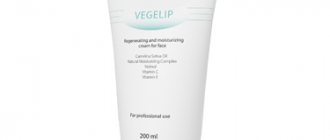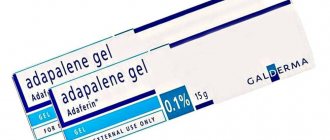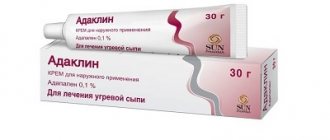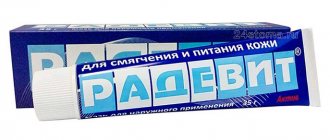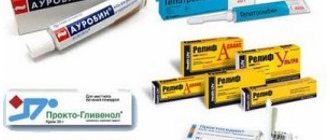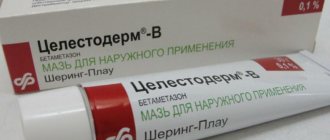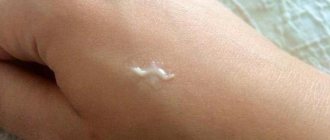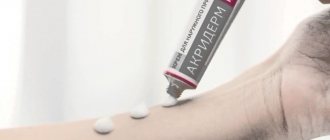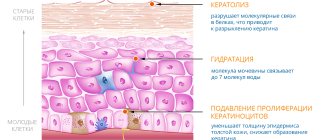Photo: Reviews and instructions for use of Retinoic ointment for wrinkles
Everyone wants to look younger and more attractive for as long as possible. But how to achieve rejuvenation and at the same time preserve your natural beauty, without resorting to quite expensive cosmetic procedures and surgery? Retinoic ointment for wrinkles today is actively popularized by cosmetologists as an alternative and inexpensive remedy for a well-known age-related defect.
Opinions about retinoic ointment constantly vary. Some claim that this remedy not only treats the upper layer of the epidermis, it also helps improve the condition of the skin at the cellular level. Others who have tried the drug are sure that acne ointment is not able to cope with wrinkles and make them less noticeable. How do you know which of these statements is true? Is retinoic ointment really capable of prolonging the youth of the skin and making it fresher and smoother?
- What is retinoic ointment for wrinkles Properties of the ointment and its main advantages
- Composition and release form
- Usage
- Contraindications and side effects from the use of ointment
- Benefit or harm? Reviews from cosmetologists
Release form and composition
Dosage form of release - ointment for external use: homogeneous, yellow to light yellow in color (in tubes of 10, 15, 20 or 35 g, in a cardboard box 1 tube).
Composition of 100 mg ointment:
- Active substance: isotretinoin – 0.05 or 0.1 mg;
- Auxiliary components: ethanol (ethyl alcohol) 95% - 10 mg, petroleum jelly - 8 mg, butylated hydroxytoluene - 0.05 mg, butylated hydroxyanisole - 0.025 mg, glycerin (glycerol) - 10 mg, emulsion wax - 8 mg, purified water - up to 100 mg.
Description of the drug
The rejuvenating effect of the external product becomes noticeable after 2 weeks of use. Retinoic ointment is a thick transparent substance with a slightly yellowish tint and a subtle smell of vitamins. It is well absorbed by the skin and penetrates into the deepest layers of the epidermis.
Many hygiene products for the care of the skin of the face, body and hair include vitamin A, or retinol. It is found in expensive creams, serums, lotions and facial washes.
Retinoic ointment for the treatment of acne and post-acne on the face consists almost entirely of fat-soluble vitamin.
It is actively used by women to eliminate facial wrinkles and prevent the formation of new ones. This property of the drug was discovered by accident. After successful acne therapy, dermatologists' patients noticed its rejuvenating effect. The effectiveness of the product is influenced by the following factors:
- concentration of the active ingredient isotretinoin;
- duration of treatment;
- number and depth of wrinkles.
The duration of use of the drug also depends on the woman’s health condition. The bioactive form of the vitamin can provoke serious local and systemic side effects.
The instructions for Retinoic ointment do not indicate the possibility of its use in cosmetology to smooth out wrinkles. Therefore, you should consult a dermatologist about the safety and advisability of its use.
Clinical and pharmacological group
Retinoic ointment is classified as a dermatropic drug. It is also used in dermatological practice as a keratolytic chemical compound.
pharmachologic effect
Retinoic ointment is not a hormonal drug.
It does not contain glucocorticosteroids, which require gradual withdrawal and have a wide range of contraindications. The drug contains only isotretinoin, which normalizes terminal cell differentiation. It prevents tissue breakdown and inhibits the proliferation of epithelium. The result is the restoration of optimal functioning of the sebaceous glands and a decrease in the viscosity of the secretion.
Thanks to its biochemical properties, the ointment has gained recognition among cosmetologists and dermatologists. It is used to improve skin condition:
- eliminates greasy shine;
- increases the firmness and elasticity of the dermis;
- smoothes out unevenness and roughness;
- eliminates facial wrinkles and smoothes out deep wrinkles;
- returns healthy complexion.
When isotretinoin penetrates the epidermis, inflammatory processes are stopped. Blood circulation and microcirculation improve in tissues. Nutrients and biologically active substances, molecular oxygen begin to penetrate into the cells.
The main ingredient of the drug stimulates the production in tissues of:
- collagen - a fibrillar protein that forms the basis of the body's connective tissue;
- elastin is a tissue protein that increases the elasticity and firmness of the skin.
Regenerative properties are provided by retinol, which also has a peeling effect.
Its keratolytic effect is based on the ability to exfoliate the upper layer of the epidermis. The keratinized scales gradually peel off, and healthy tissues form in their place.
Release form and composition
The active component of the drug is isotretinoin - a biologically active form of fat-soluble vitamin A. The drug is produced by a domestic manufacturer in the form of 0.05% and 0.1% ointment.
It is packaged in aluminum, hermetically sealed tubes of 10.0 g. The secondary packaging is a cardboard box with attached instructions for use.
Retinoic ointment contains the following auxiliary ingredients:
- butylated hydroxytoluene;
- emulsion wax;
- ethanol;
- distilled water;
- Vaseline oil.
The preparation also contains butyloxyanisole. This antioxidant is used to prevent oxidation of topical ingredients. Despite the presence of wax and petroleum jelly, after applying the ointment there is no greasy shine left on the face. Auxiliary and active ingredients are quickly absorbed by the epidermis.
Storage conditions and periods
Retinoic cream should be stored in a dark place at a temperature of 2–8 °C. At lower values, especially when frozen, it completely loses its therapeutic properties. Small children should not have access to the drug.
The shelf life is 24 months. After opening the tube, it is limited to 2 weeks. The medicine should not be used if its consistency, color or odor has changed.
Pharmacodynamics and pharmacokinetics
Isotretinoin, the active ingredient of the drug, is one of the forms of vitamin A that has biological activity. It inhibits hyperproliferation of the epithelium of the excretory ducts of the sebaceous glands and terminal differentiation of sebocytes, normalizes the composition of the secretion of the sebaceous glands and facilitates its excretion. As a result, the production of sebum is reduced and the number of foci of inflammation around the glands is reduced. Retinoic ointment is characterized by keratolytic, anti-inflammatory and antiseborrheic effects. The drug also increases the intensity of regeneration processes in the skin.
Analogs
Some drugs have the same active substance as retinoic ointment.
These include:
- Isotretinoin. A structural analogue of retinol reduces the activity of the sebaceous glands, reduces the thickness of the surface of the stratum corneum of the epithelium and removes wrinkles. Side effects include redness, peeling, and tingling of the skin.
- Retasol. The solution normalizes the process of cell division and is indicated for seborrheic dermatitis, rosacea and acne. Its contraindications are the same as for retinoic ointment.
- Will erase. Used for severe forms of acne. Available in capsules and not allowed during pregnancy.
- Verocutan. Sold in the form of capsules for oral use. Indicated for severe acne and prohibited in case of excess vitamin A, pregnancy, liver failure and breastfeeding.
According to the mechanism of action, the product is similar to the following ointments:
- Arthromax;
- Desquam;
- Proderm.
Most of these analogues provide for a long course of treatment. They are used only after consultation with a dermatologist.
To summarize, it is worth saying that retinoic ointment copes well with the problem of acne and fine wrinkles. This is proven by real customer reviews.
In any case, the final result and skin reaction are very individual. The main thing is to know how to apply the ointment correctly and not to exceed the dosage.
Contraindications
- Combined use with other drugs from the retinoid group;
- The period of pregnancy, pregnancy planning and breastfeeding (when used on large areas of skin);
- Hypersensitivity to the components of the drug.
Relative (Retinoic ointment is prescribed with caution in the presence of the following diseases/conditions):
- Decompensation of cardiac activity;
- Chronic pancreatitis;
- Chronic kidney/liver diseases.
Price (region - Moscow)
Are you wondering how much Retinoic ointment costs at the pharmacy? Many people want to figure this out as soon as they hear reviews about the incredible effectiveness of the ointment in the fight for youth and beautiful skin. If the drug is not available in pharmacies, which happens often lately, the consumer can order it from a catalog in online stores. The average cost in Moscow across pharmacy chains is shown in the table:
| Volume | Price, 0.05%, rubles | Price, 0.1%, rubles |
| 10 g | 230-276 | 273-326 |
| 15 g | 241-353 | 298-425 |
Side effects
In the second week of using Retinoic acne ointment, an aggravation may occur in the form of itching, new rashes, peeling/redness of the skin. In cases of severe reactions, it is recommended to interrupt treatment for several days (until they subside).
In some cases, if there is individual sensitivity at the beginning of the course (the first or second day of using the ointment), swelling, maculopapular rashes and itching may develop. In these cases, therapy is discontinued.
With prolonged use, symptoms of chronic hypervitaminosis A may occur (in the form of cheilitis, conjunctivitis, dry/flaky skin).
Instructions for use
Retinoic ointment helps get rid of wrinkles that have formed on the forehead and in the nasolabial triangle.
It cannot be used on areas with thin skin, and it is strictly prohibited to apply it around the eyes.
Isotretinoin accelerates the exfoliation of the epidermis, which causes its thinning. To eliminate wrinkles, a course of the drug is required for several months. What is Retinoic ointment used for:
- to reduce the production of sebaceous secretions;
- to improve complexion and eliminate age spots;
- to increase the elasticity of the dermis.
After 2-3 weeks of treatment you need to take a 10-day break. During therapy, the following recommendations of cosmetologists and dermatologists must be followed:
- refuse to visit the solarium;
- Avoid direct sunlight on your face.
Ultraviolet radiation in combination with Retinoic ointment will cause spots to form. Therefore, the optimal time for treatment procedures is autumn and winter. It is better to apply the drug before bed.
You will also have to stop using the following care cosmetics:
- alcohol lotions and tonics;
- scrubs with large abrasive particles;
- serums and creams with fruit acids.
After a few days of using retinol ointment, your skin condition may worsen. Severe rashes form on it, and in places it swells and turns red. It is necessary to discontinue the drug for a week to completely restore damaged tissue. Then treatment is resumed.
Indications and contraindications
Retinoic ointment helps get rid of not only wrinkles and age spots. It is prescribed for the treatment of certain infectious and inflammatory skin diseases.
Isotretinoin is included in therapeutic regimens when a patient is diagnosed with:
- perioral dermatitis;
- acne vulgaris;
- seborrheic dermatitis;
- Rosacea.
In the treatment of severe acne, local and systemic dosage forms of isotretinoin are combined. Retinoic ointment has the following contraindications for use:
- lactation period;
- excess content and (or) poor absorption of vitamin A;
- individual intolerance to the active or auxiliary components.
The drug is characterized by a pronounced teratogenic effect, therefore its use by pregnant women is strictly prohibited. The medicine should be used with caution by people with pathologies of the liver and genitourinary system.
We recommend
A detailed review of the anti-wrinkle and acne product Regetsin.
Directions for use and doses
For cosmetic purposes, Retinoic ointment is used in the form of masks or by simple application to problem areas. The treatment procedure is carried out as follows:
- after washing with soap, foam or cleansing gel, the skin should be dried with a towel;
- apply the ointment locally to the wrinkles and lightly tap in with your fingertips;
- leave for 30-40 minutes, then rinse with warm water.
A mask of Retinoic ointment is used to prevent the formation of facial or deep wrinkles. To prepare it, you need to add 1-2 g of the drug to 100 ml of nourishing or moisturizing cream. The mask should be applied daily for 1-2 weeks for 2 hours. If discomfort occurs, it should be washed off and the skin wiped with a tonic that does not contain alcohol.
Side effects and special instructions
Irrational use of Retinoic ointment may cause local adverse reactions. They are especially often diagnosed in patients with very sensitive or dry skin. A small red rash forms on it, itching, swelling and excessive peeling occur.
Treatment with Retinoic ointment sometimes leads to systemic side effects:
- headaches and dizziness;
- indigestion and peristalsis;
- increased frequency and intensification of bleeding
- decreased visual and hearing acuity;
- increased blood pressure.
Compliance with the dosages recommended by your dermatologist will help prevent the occurrence of negative effects. Do not exceed the duration of the therapeutic course or apply the product to injured skin.
Reviews of Retinoic ointment
Most reviews about Retinoic ointment are positive. Patients claim that this is a very effective remedy for treating acne, but warn against using it during pregnancy or planning pregnancy. Despite the fact that the drug helps, some patients note that it has side effects, the most common of which are dry skin, rashes, and pain.
Doctors also recommend using Retinoic ointment as a remedy for wrinkles. Many women say that its regular use promotes regeneration and renewal of the epidermis, providing a rejuvenating effect.
Additional Information
During treatment, exposure to direct sunlight should be avoided so as not to cause skin burns and the appearance of age spots. It is also prohibited to undergo UV therapy. When using the ointment, contact lens intolerance may occur. There have been no studies to confirm the safety of use in children, so it should be used with caution. During the treatment period, it is not recommended to take vitamin A so as not to cause hypervitaminosis.
Read more How to use Ortofen gel - instructions, price and reviews
The product must be stored away from sunlight and children at a temperature of 2-8°C. At low temperatures, including freezing, the product loses its therapeutic effect, as the active component is destroyed. Shelf life is 2 years from the date of manufacture of the drug, which is indicated on the tube. After opening the ointment, it can be used for 2 weeks. If before this time the ointment has changed its consistency, smell, or color, it must be disposed of.
The average cost of Retinoic ointment is about 200 rubles. The exact price depends on the region of residence, pharmacy chain, concentration, and volume of the drug.
